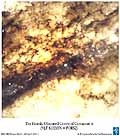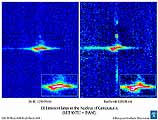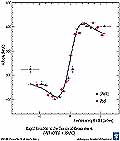Information from the European
Southern Observatory
ESO Press Release
04/01
8 March 2001
For immediate release |
|
A Supermassive Black Hole
in a Nearby Galaxy
ISAAC Inspects the Center of
Centaurus A
|
Summary
The nearby galaxy Centaurus
A harbours a supermassive black hole at its
centre .
Using the ISAAC
instrument at the ESO Very Large
Telescope (VLT) , an international team of
astronomers [1]
has peered right through the spectacular dust
lane of the peculiar galaxy Centaurus A , located
approximately 11 million light-years away.
They were able to probe the thin disk of
gas that surrounds the very center of this
galaxy. The new measurements show that the compact nucleus in the middle
weighs more than 200 million solar masses
!
This is too much just to be due to normal
stars. The astronomers thus conclude the
existence of a supermassive black
hole lurking at the centre of Centaurus A
.
PR
Photo 08a/01 : Visual image of the centre of Centaurus A .
PR
Photo 08b/01 : ISAAC spectrum
of the centre of Centaurus A .
PR
Photo 08c/01 : The corresponding rotation curve from which the
mass of the black hole was
deduced.
|
A well studied galaxy with a
hidden center
|

ESO PR Photo
08a/01
[Preview
- JPEG: 352 x 400 pix - 160k]
[Normal
- JPEG: 704 x 800 pix - 376k]
|
Caption : PR Photo 08a/01 shows a small
area in the direction of the heavily obscured
centre of the peculiar radio galaxy Centaurus A , as seen in visual
light. It measures about 80 x 80
arcsec2, or 4400 x 4400
light-year2 at the distance of this
galaxy, and has been reproduced from exposures
made with the FORS2 multi-mode instrument at the
8.2-m VLT KUEYEN telescope at Paranal. The full
field may be seen in PR
Photo 05b/00 . Technical
information about this photo is available
below. |
The galaxy Centaurus A (NGC
5128) is one of the most studied objects in
the southern sky. The unique appearance of this
galaxy was already noticed by the famous British
astronomer John
Herschel in 1847 who catalogued the southern
skies and made a comprehensive list of "nebulae".
A fine photo of Centaurus A
from the VLT was published last year as PR
Photo 05b/00 .
Herschel could not know, however, that this
beautiful and spectacular appearance is due to an
opaque dust lane that covers the central part of
the galaxy. This dust is likely the remain of a
cosmic merger between a giant elliptical galaxy,
and a smaller spiral galaxy full of dust.
Centaurus A is even more
spectacular when observed with radio telescopes.
It is in fact one of the brightest radio sources
in the sky (its name indicates that it is the
strongest radio source in the southern
constellation Centaurus). At a distance of merely
11 million light-years, it is also the nearest
radio galaxy. The radio emission from the very
compact centre exhibits strong activity. It has
for some time been suspected that this powerful
energy release is due to accretion of material
onto a massive black hole.
The details of the centre have remained largely
unknown, due to the dense dust lane that
completely obscures the central part of the galaxy
in optical light, cf. PR Photo
08a/01 . Observations of the dust emission in
the mid-infrared spectral region were carried out
with the ISOCAM camera onboard the ESA Infrared Space Observatory .
They revealed a structure
extending over 5 arcmin (16,500 light-years or
5 kpc), centred on the compact radio source, and
very similar to that of a small barred galaxy.
This bar may serve to funnel gas towards the
active nucleus of the galaxy.
Peering through the
dust
To look into the very centre of the galaxy, the
observations must be carried out at wavelengths
longer than those of visual light, e.g., in the
infrared spectral region. This is because the dust
absorbs much less the infrared radiation. Infrared
observations of the innermost regions (of Centaurus A (on an arcsec scale)
were recently done by a team of astronomers from
Italy, UK and USA [1],
by means of the multi-mode ISAAC
instrument on the ESO Very Large Telescope
(VLT) at Paranal Observatory.
In fact, the team started their infrared
studies of this galaxy already in 1997, using the
NICMOS camera on board the Hubble Space Telescope (HST) .
That close view of the galaxy nucleus revealed a
thin gaseous disk of material close to the center,
which looked very much like an accretion disk that
was feeding material into a central black hole.
The HST image prompted further spectroscopic
observations to probe the rotation of the disk,
and thus to measure the mass of the central
object.
The ISAAC spectra
|

ESO PR Photo
08b/01
[Preview
- JPEG: 400 x 303 pix - 216k]
[Normal
- JPEG: 800 x 606 pix - 572k]
[Hires
- JPEG: 2274 x 3000 pix - 4.0M]
|
Caption : PR Photo 08b/01 shows two
wavelength regions of one of the infrared ISAAC spectra of the center of
Centaurus A . The direction
of the long spectrograph slit is vertical and
the dispersion (wavelength) direction is
horizontal; longer wavelengths are towards the
right. The two emission lines shown originate in
singly ionized Iron ([FeII]; rest wavelength
1256.68 nm) and in Hydrogen (Paschen-Beta;
1281.81 nm) and both are clearly tilted. This is
due to the rapid rotation of the accretion disk
surrounding the supermassive black hole in the
center of the galaxy. The light from the
receding edge of the disk is Doppler-shifted
towards the red (to the right) and the light
from the part of the disk approaching us is
shifted to the left. This may be better seen in
the inserted enlargements. Therefore the
inclined disk shows a tilted spectrum. These
motions may be represented in a rotation curve,
cf. PR Photo 08c/01 . There
are other emitting areas above and below the
nucleus, especially in the Paschen-Beta line. Technical
information about these photos is available
below. |
|

ESO PR Photo
08c/01
[Preview
- JPEG: 341 x 400 pix - 56k]
[Normal
- JPEG: 682 x 800 pix - 132k]
|
Caption : PR Photo 08c/01 shows the rotation curve (velocity vrs.
distance from the centre) of the disk
surrounding the black hole at the centre of Centaurus A . From the ISAAC
spectrum displayed in PR Photo
08b/01 , the `average' gas velocities along
the slit direction can be derived. Position `0'
on the horizontal axis indicates the exact
position of the galaxy nucleus; at the distance
of Centaurus A , 1 arcsec
corresponds to 55.5 light-years (17 pc). The
blue triangles and the red squares correspond to
emission lines from singly ionized Iron atoms
([Fe II]) and Hydrogen (Paschen-Beta),
respectively. The high velocities are the
hallmark of a central black hole. The thick
solid line represents the expected velocities,
assuming the presence of a 200 million
solar-mass black hole at the centre. Technical
information about these photos is available
below. |
The spectroscopic observations required both a
high sensitivity in the infrared and excellent
seeing conditions. This combination was achieved
using ISAAC at VLT. Peering through the thick
walls of dust enshrouding the nuclear region of Centaurus A , the astronomers
succeeded in acquiring several high-quality
spectra of the thin central disk; the exposure
time for each spectrum was (about) 35 min.
The spectra did show the characteristic shape
of a rotating disk, cf. PR Photo
08b/01 . High-speed motions of the gas in this
disk were detected (PR Photo
08c/01 ), which are the hallmark of a black
hole. An analysis of the rotational speed of the
disk leads to determination of the total mass of
the material inside the disk. This showed that
about 200 million solar masses of material resides
inside the nuclear disk.
A massive black hole
The astronomers quickly realized that this
enormous mass within the central region cannot be
caused by normal stars, as it would then be much
more luminous. Instead they conclude that the most
conservative explanation for the dark, central
mass concentration observed in Centaurus A is indeed a
supermassive black hole. The most likely mass of
this "central beast" is then about 200 million
times the mass of our Sun.
This discovery confirms the previous suspicion
that the active nucleus of Centaurus A is powered by a
supermassive black hole. It is the first time
infrared spectroscopy has been used to weigh a
black hole. Many other galaxies have
dust-enshrouded nuclei, and the excellent
capabilities of ISAAC now hold a great potential
to discover and weigh many more black holes.
More Information
The research described in this Press Release is
reported in a research article ("Peering through
the dust: Evidence for a supermassive Black Hole
at the Nucleus of Centaurus A from VLT IR
spectroscopy"), that will appear in the
international research journal the Astrophysical
Journal on March 10, 2001. The full article is
also available on the web as astro-ph/0011059 .
Note
[1]: The team is composed by
Ethan Schreier (Principal Investigator;
Space Telescope Science Institute - STScI,
Baltimore, USA), Alessandro Marconi
(Arcetri Observatory, Italy), Alessandro
Capetti (Turin Observatory, Italy), David
Axon (University of Hertfordshire, United
Kingdom), Anton Koekemoer (STScI, USA) and
Duccio Macchetto (ESA/STScI, USA).
PR Photo 08a/01 is
reproduced from three exposures, obtained during
the night of January 31 - February 1, 2000. It is
a composite of three exposures in B (300 sec
exposure, image quality 0.60 arcsec; here rendered
in blue colour), V (240 sec, 0.60 arcsec; green)
and R (240 sec, 0.55 arcsec; red). The field
covered corresponds to about 80 x 80
arcsec2 (395 x 395 pix2, 1
pix = 0.2 arcsec). North is up and East is left.
PR Photo 08b+c/01 : The
original ISAAC spectra were exposed for 35 min
each with an average seeing of 0.5 arcsec. Three
spectrograph slits were used, but only one of
these is shown here. It was centered on the
nucleus of Centaurus A and oriented at 33°,
measured counter-clockwise from the North
direction. The spectral pixel size is 0.6 Angstrom
x 0.15 arcsec (i.e., 14 km/sec x 8.3 light-year).
The large and small figures cover 2300 km/s x 1665
light-years and 1150 km/s x 330 light-years,
respectively.
Contacts
Alessandro Marconi
Arcetri
Observatory
Firenze, Italy
Tel.: +39 055
2752250
email: marconi@arcetri.astro.it
David Axon
University of
Hertfordshire
Hatfield, UK
Tel:
+44-1707-284607
email: dja@star.herts.ac.uk
Ethan Schreier
Space Telescope
Science Institute
Baltimore, USA
Tel:
+1-410-338-4740
email: ejs@stsci.edu
Anton Koekemoer
Space Telescope
Science Institute
Baltimore, USA
© ESO Education & Public Relations
Department
Karl-Schwarzschild-Strasse 2,
D-85748 Garching, Germany
|

